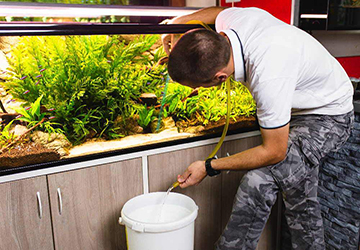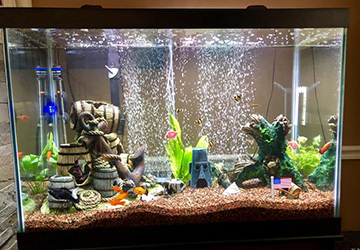Top Tips for Keeping Your Aquarium Clean and Healthy
For aquarium enthusiasts, ensuring a clean and vibrant aquatic environment isn't just about aesthetics; it's crucial for your fish's and aquatic plants' well-being. Regular maintenance and understanding of the marine ecosystem are pivotal. This article delves deep into the best aquarium maintenance practices, methods to prevent algae in fish tanks, techniques to clean aquarium gravel, and strategies to ensure optimal water clarity.
Best Aquarium Maintenance Practices
● Regular Water Changes: One of the fundamental best aquarium maintenance practices is to change about 20-30% of the water regularly. This helps in removing waste products while also replenishing essential minerals.
● Check Water Parameters: It's vital to regularly test the pH, ammonia, nitrite, and nitrate levels. Keeping these parameters in balance ensures a safe environment for your aquatic inhabitants.
● Clean Filters Monthly: Filters trap debris, waste, and sometimes beneficial bacteria. Cleaning them once a month prevents them from becoming clogged and maintains their efficiency.
● Avoid Overfeeding: Fish excrement and food detritus degrade water quality. Only feed fish what they can eat in 2-3 minutes.

Preventing Algae in Fish Tanks
● Limit Light Exposure: Algae thrive in well-lit conditions. Limiting the light your aquarium receives is a primary step to prevent algae in fish tanks. Keeping the lights on for 8-10 hours daily is advisable.
● Introduce Algae-eating Species: Species like Otocinclus catfish or certain snails can help keep algae levels in check by naturally feeding on them.
● Regular Cleaning: An algae scraper or magnet can assist in removing algae from the tank walls.
● Control Nutrient Levels: High nutrient levels, especially nitrates and phosphates, can fuel algae growth. Regular water changes and avoiding overfeeding can keep these levels balanced.
How to Clean Aquarium Gravel
● Use a Gravel Vacuum: A gravel vacuum is one of the most efficient methods to clean aquarium gravel. It allows deep cleaning by sucking debris between the stone without disturbing the substrate layers.
● Rinse Before Introducing: When adding new gravel, ensure it's rinsed thoroughly to remove dust or foreign particles.
● Stirring the Gravel: Occasionally stirring the gravel ensures that waste isn't embedded deep within. It brings debris to the surface, making removing it easier during water changes.
Ensuring Fish Tank Water Clarity
● Activated Charcoal: Activated charcoal in your filter can help ensure water clarity of the fish tank. It effectively removes tannins and impurities from the water.
● Use a Water Clarifier: These products clump microscopic particles, making it easier for the filter to trap them.
● Avoid Overstocking: More fish means more waste. Stocking your aquarium responsibly ensures that waste levels remain manageable, directly impacting water clarity.
● Plants to the Rescue: Live aquatic plants absorb many nutrients that cloud water. They act as natural filters and enhance the overall ecosystem.
Understanding the Nitrogen Cycle
One of the foundational aspects of aquarium health is understanding the nitrogen cycle. This natural process helps break down harmful waste products into less toxic substances.
● Beneficial Bacteria: These microscopic heroes convert ammonia (from fish waste) into nitrites and then into nitrates. Cultivating a healthy colony of these bacteria is essential. Adding live bacteria supplements can speed up the cycling process of new tanks.
● Regular Testing: As part of your best aquarium maintenance practices, it's vital to check for ammonia, nitrite, and nitrate levels. While ammonia and nitrites should always be zero, nitrates should be kept low with regular water changes.
Handling Unwanted Guests: Disease and Parasites
An ounce of prevention is worth a pound of cure, especially when dealing with aquatic diseases.
● Quarantine New Additions: Before introducing new fish or plants to your main tank, keep them in a separate quarantine tank for a few weeks. This allows you to observe them for signs of illness or parasites, preventing potential outbreaks in your primary aquarium.
● Use Quality Food: Ensure you provide your fish with high-quality food. Poor-quality or expired food can lead to health problems and, subsequently, can deteriorate the water quality.

Calibrating Your Equipment
Your aquarium equipment, like heaters, lights, and filters, need regular checks to ensure they function correctly.
● Thermostat Checks: A malfunctioning heater can lead to temperature spikes or drops, stressing your fish. Regularly compare your heater's reading with a separate aquarium thermometer to ensure accuracy.
● Filter Maintenance: Beyond cleaning, ensure the filter's flow rate is consistent with your tank's requirements. An underperforming filter might not circulate water adequately, leading to dead spots, while an overly aggressive one might stress your fish.
Decor and Plants Maintenance
The aesthetics of your tank, including decor and plants, also play a role in its health.
● Clean Decors: Ornaments can accumulate algae and debris. Periodically remove them from the tank and scrub them gently using aquarium-safe brushes or cleaners.
● Prune Plants: Like in a garden, aquatic plants might need occasional pruning. Remove dead or decaying leaves, as they can contribute to the waste in the tank and cloud the water.
Seasonal Adjustments
Just as terrestrial environments change with the seasons, your aquarium might also need some seasonal tweaks:
● Temperature Shifts: The ambient room temperature might drop in cooler months, and your aquarium heater will work harder. Ensure it's up to the task, and consider adding a backup heater for larger tanks. During warmer months, a cooling fan or aquarium chiller might be necessary for tanks that tend to overheat.
● Light Duration: Natural daylight varies with seasons. Adjust your aquarium lights' duration, especially if the tank is near a window receiving direct sunlight.
Feeding Variety for Health
Diversity in diet is as essential for fish as it is for humans.
● Varied Diet: While sticking to quality pellet or flake food is crucial, occasionally introducing live or frozen foods like brine shrimp or bloodworms can offer essential nutrients and enrich your fish's diet.
● Vegetable Supplements: Some fish, especially certain cichlids and goldfish, benefit from blanched vegetables like zucchini, spinach, or peas.
In the end, the beauty of an aquarium lies in its delicate balance. Each element, from the water quality to the fish, plants, and equipment, plays a role in creating a harmonious aquatic environment. By being proactive and understanding the intricacies of your tank, you can ensure a healthy, thriving ecosystem that provides endless hours of enjoyment and tranquillity.




